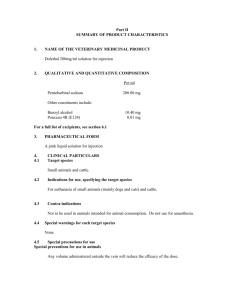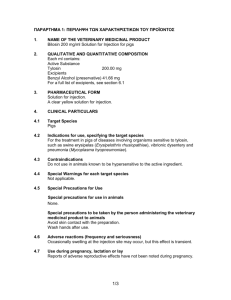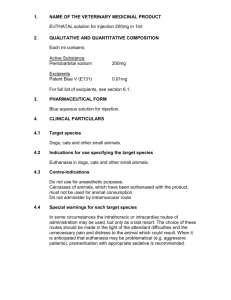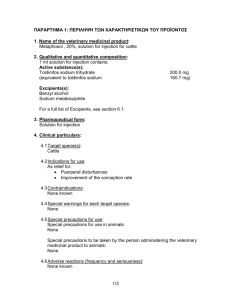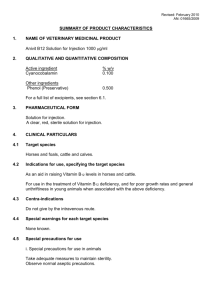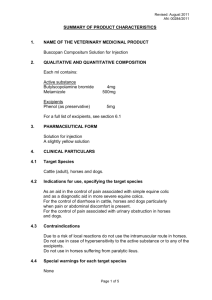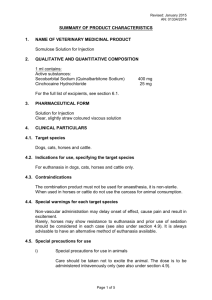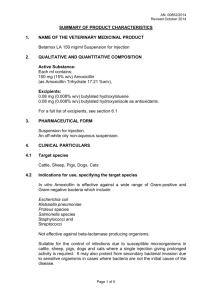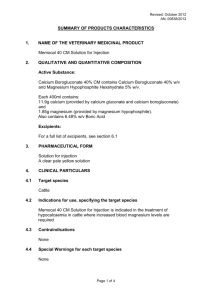AN: 01452/2014 Revised: April 2015 SUMMARY OF PRODUCT CH
advertisement
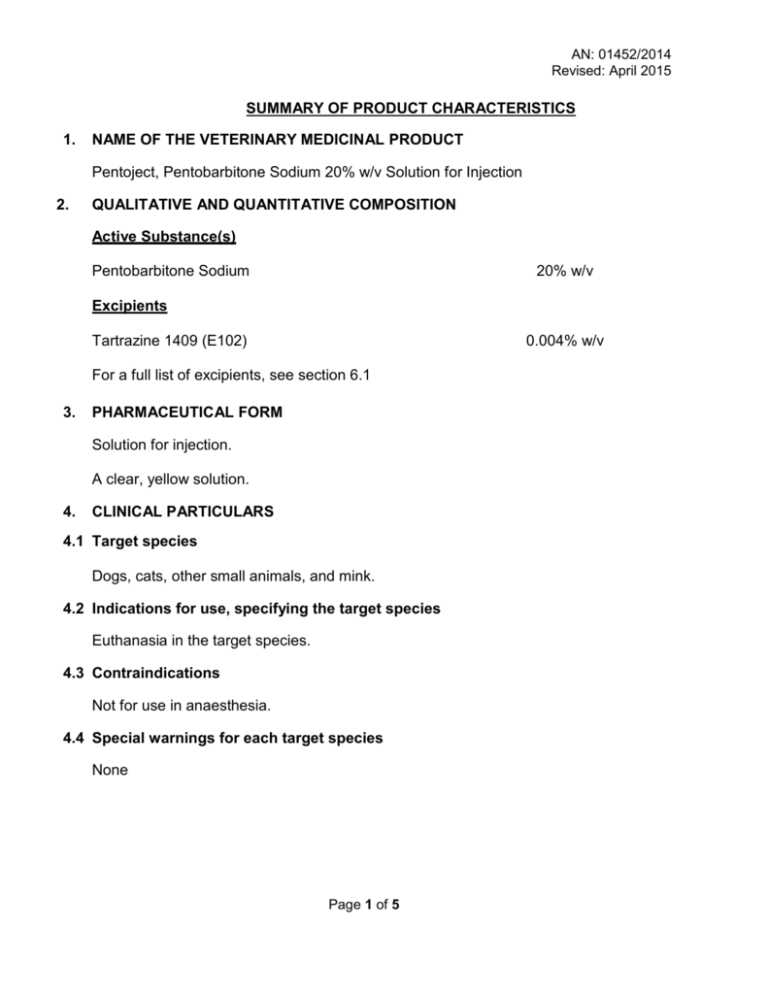
AN: 01452/2014 Revised: April 2015 SUMMARY OF PRODUCT CHARACTERISTICS 1. NAME OF THE VETERINARY MEDICINAL PRODUCT Pentoject, Pentobarbitone Sodium 20% w/v Solution for Injection 2. QUALITATIVE AND QUANTITATIVE COMPOSITION Active Substance(s) Pentobarbitone Sodium 20% w/v Excipients Tartrazine 1409 (E102) 0.004% w/v For a full list of excipients, see section 6.1 3. PHARMACEUTICAL FORM Solution for injection. A clear, yellow solution. 4. CLINICAL PARTICULARS 4.1 Target species Dogs, cats, other small animals, and mink. 4.2 Indications for use, specifying the target species Euthanasia in the target species. 4.3 Contraindications Not for use in anaesthesia. 4.4 Special warnings for each target species None Page 1 of 5 AN: 01452/2014 Revised: April 2015 4.5 Special precautions for use i) Special precautions for use in animals Use only for euthanasia. ii) Special precautions for the person administering the veterinary medicinal product to animals In the event of accidental self-administration, by injection or skin absorption, seek URGENT medical attention advising the medical services of barbiturate poisoning and show this advice. This is a potent drug which is toxic in man – particular care should be taken to avoid accidental ingestion and self-injection. In the event of accident the following action should be taken: Skin – Wash immediately with water and then thoroughly with soap and water. Eyes – Wash immediately with cold water and obtain medical advice. Ingestion – Obtain medical attention immediately. Wash out mouth. Keep warm and rest. Accidental self- injection – Obtain URGENT medical attention, advising medical services of barbiturate poisoning. Do not leave patient unattended. Advice to Doctor – Maintain airways and give symptomatic and supportive treatment. This product is not sterile. iii) Other precautions None 4.6 Adverse reactions (frequency and seriousness) Body spasms may occur in some animals which may distress observers. Very low frequency when an appropriate dose is used and administered rapidly. 4.7 Use during pregnancy, lactation or lay Not applicable. 4.8 Interaction with other medicinal products and other forms of interaction Not applicable. Page 2 of 5 AN: 01452/2014 Revised: April 2015 4.9 Amount(s) to be administered and administration route To effect, usually 0.4 ml/kg in debilitated or elderly animals, or 0.6-0.8 ml/kg in younger or more fit animals. These dosages correspond to 80 mg/kg or 120-160 mg/kg, respectively. Preferably by rapid intravenous injection. The intravenous route of administration should be the route of choice if possible but alternatives such as intraperitoneal or intramuscular are available when venepuncture is difficult to achieve (e.g. in cats). In some circumstances the intrathoracic route may be used but this is usually the last resort. There is a risk of injection into the lungs which causes coughing and distress. Direct injection into a chamber of the heart is rapid, but it may be difficult to accurately locate the heart chamber in larger dogs and repeated attempts could cause unnecessary pain and distress. When it is predicted that euthanasia may be problematical (i.e. aggressive patients), it is recommended that premedication with an appropriate sedative be given. 4.10 Overdose (symptoms, emergency procedures, antidotes), if necessary If accidentally administered to an animal not presented for euthanasia, care should be aimed at supporting the respiratory and cardiovascular systems. Use of artificial respiration, oxygen and analeptics are appropriate. 4.11 Withdrawal period Not for use in animals intended for human or animal consumption. 5. PHARMACOLOGICAL PROPERTIES Pharmacotherapeutic group: Barbiturates ATC Vet Code: QN51AA01 5.1 Pharmacodynamic properties Pentobarbitone Sodium is a barbiturate. Injection of lethal doses causes progressive depression of the central nervous system, which may be considered as passing through the following sequential phases: i) sedation, ii) intoxication, possibly with involuntary excitement, iii) anaesthesia, (iv) respiratory arrest and subsequent cardiac failure. Page 3 of 5 AN: 01452/2014 Revised: April 2015 6. PHARMACEUTICAL PARTICULARS 6.1 List of excipients Tartrazine 1409 (E102) Glycerol Industrial Methylated Spirit Water for Injections 6.2 Incompatibilities None known 6.3 Shelf life Shelf life of the veterinary medicinal product as packaged for sale: 3 years 6.4 Special precautions for storage Do not store above 25ºC. Protect from light. This product does not contain any antimicrobial preservative. Following withdrawal of the first dose use within 28 days. Discard unused material. 6.5 Nature and composition of immediate packaging 100 ml, Amber, Type II glass vial with a centre-hole aluminium seal and a chlorobutyl rubber bung. 500 ml, Amber, Type II glass vial with an aluminium over seal and a chlorobutyl rubber bung. Not all pack sizes may be marketed. 6.6 Special precautions for the disposal of unused veterinary medicinal product or waste materials derived from the use of such products, if appropriate Any unused product must be destroyed in accordance with the Misuse of Drugs Regulations (2001). Any waste material should be disposed of in accordance with local requirements. Page 4 of 5 AN: 01452/2014 Revised: April 2015 7. MARKETING AUTHORISATION HOLDER Animalcare Ltd 10 Great North Way York Business Park Nether Poppleton York Yorkshire YO26 6RB 8. MARKETING AUTHORISATION NUMBER Vm 10347 / 4014 9. DATE OF FIRST AUTHORISATION Date: 21 October 1993 10. DATE OF REVISION OF THE TEXT Date: April 2015 APPROVED Page 5 of 5 24/04/15
